
|

|
My Camera Equipment
Sealife Reefmaster CL 35mm Film Camera
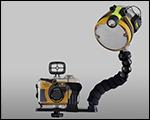
 This is where it all started, by reading up as much as I could I realised that the camera was just
one element of taking acceptable underwater photographs. The image to the right shows the outfit I
purchased, complete with matched strobe and aiming light. The outfit did have quite a number of
limitations, the main one being the limitation of the lens. Without the addition of expensive
close-up add-on lens, the camera had a long minimum focus length, which was difficult to work with,
but it did produce some nice images, you can see some of them in the Northern Red Sea gallery.
This is where it all started, by reading up as much as I could I realised that the camera was just
one element of taking acceptable underwater photographs. The image to the right shows the outfit I
purchased, complete with matched strobe and aiming light. The outfit did have quite a number of
limitations, the main one being the limitation of the lens. Without the addition of expensive
close-up add-on lens, the camera had a long minimum focus length, which was difficult to work with,
but it did produce some nice images, you can see some of them in the Northern Red Sea gallery.
|
Homemade Modified Ikelite Housing
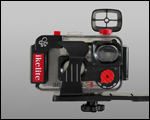
 This was in the very early days of digital photography; I had a Premier DC600 digital camera
which had a optical macro function, as the main secret to underwater photography "is to
get close and then more some", this seemed a good way to go, with the live view on the back
this would lessen the leaning curve considerably. The Housing I used was a Ikelite compact 35mm
housing which had a flash window where the Premier's lens was, so a scrapped housing's lens unit
was grafted on to the housing. The lens macro switch and digital buttons manufactured and fitted to
the housing to complete the modification. This outfit also used the Sealife tray and strobe unit,
some images from this camera are in the Northern Red Sea gallery.
This was in the very early days of digital photography; I had a Premier DC600 digital camera
which had a optical macro function, as the main secret to underwater photography "is to
get close and then more some", this seemed a good way to go, with the live view on the back
this would lessen the leaning curve considerably. The Housing I used was a Ikelite compact 35mm
housing which had a flash window where the Premier's lens was, so a scrapped housing's lens unit
was grafted on to the housing. The lens macro switch and digital buttons manufactured and fitted to
the housing to complete the modification. This outfit also used the Sealife tray and strobe unit,
some images from this camera are in the Northern Red Sea gallery.
|
Canon Compact with 16mm Wide Angle Lens
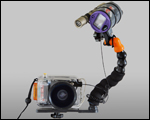
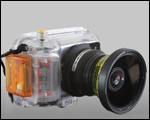 By now the underwater photography "bug" had really bitten hard, and digital was the way to go.
I purchase a Canon A40 with a WP-DC200s housing, again using the original Sealife camera tray
and “bendy” arm, the learning curve was being shortened considerably, by being able to use the
rear preview screen rather than the viewfinder, you can, by pushing the camera in front of you
position yourself further away from the subjects zone of tolerance, giving you less chance of
scaring away easily frightened fish. With the quest of getting closer to the subject a Sea & Sea
16mm F5.6 wide angle lens was incorporated into the kit, with digital cameras becoming more
sophisticated in their flash technology a dedicated Epoque ES 150 digital strobe was required to
complete the outfit. The strobe is triggered by a fibre optic synchronisation lead. With this kit
I was achieving very good images, examples of which are in Dahab, and British galleries.
By now the underwater photography "bug" had really bitten hard, and digital was the way to go.
I purchase a Canon A40 with a WP-DC200s housing, again using the original Sealife camera tray
and “bendy” arm, the learning curve was being shortened considerably, by being able to use the
rear preview screen rather than the viewfinder, you can, by pushing the camera in front of you
position yourself further away from the subjects zone of tolerance, giving you less chance of
scaring away easily frightened fish. With the quest of getting closer to the subject a Sea & Sea
16mm F5.6 wide angle lens was incorporated into the kit, with digital cameras becoming more
sophisticated in their flash technology a dedicated Epoque ES 150 digital strobe was required to
complete the outfit. The strobe is triggered by a fibre optic synchronisation lead. With this kit
I was achieving very good images, examples of which are in Dahab, and British galleries.
|
Canon EOS 300D in a Ikelite Housing
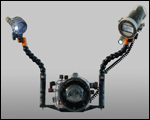
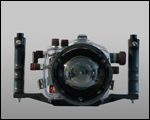 Compact cameras do have one major limitation when used underwater – shutter lag, because of the
low light levels, the camera is making many calculations before taking the picture, this equals delay
from pressing the shutter to the taking of the image. You may be further away from the subjects
zone of tolerance, but the success of taking a well composed picture could be as low as 30-40%. The way to
overcome shutter lag was to upgrade again. This is my latest and most sophisticated camera outfit, a
housed digital SLR camera a Canon EOS 300D in an Ikelite housing. The beauty of an SLR camera is that it will
take a picture instantly at any setting right or wrong, so shutter lag became a thing of the past,
but because you have to use the viewfinder, a more considered approach to your subject is required.
Compact cameras do have one major limitation when used underwater – shutter lag, because of the
low light levels, the camera is making many calculations before taking the picture, this equals delay
from pressing the shutter to the taking of the image. You may be further away from the subjects
zone of tolerance, but the success of taking a well composed picture could be as low as 30-40%. The way to
overcome shutter lag was to upgrade again. This is my latest and most sophisticated camera outfit, a
housed digital SLR camera a Canon EOS 300D in an Ikelite housing. The beauty of an SLR camera is that it will
take a picture instantly at any setting right or wrong, so shutter lag became a thing of the past,
but because you have to use the viewfinder, a more considered approach to your subject is required.
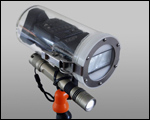
 Like all underwater photography you need to enhance the available light, this outfit was assembled
when most other DSLR outfits were still using manual flash settings on their strobes. Canon had an E-TTL flash
unit the Speedlite 420EX, but there was no housing available so I made my own acrylic housing with Ikelite strobe
bulkheads using the metal shell as the sixth contact to accommodate Canon’s 6 wire pin outs. The flash unit did
need a modification to the electronics, when the flash unit is flattened out the internal light reflectors
close up for a longer focus length, a switch was fitted to the Speedlite 420EX to allow the light reflectors to copy
the lens zoom range. This was one of the first E-TTL DSLR underwater camera outfits in Europe, coupled with
Canon’s fast auto-focus this is a very capable camera set up. The Epoque strobe unit is now used as a “fill in”
slave strobe to lessen the shadow effect from the main strobe. All of the Southern Red Sea and Caribbean
photographs were taken with this camera outfit.
Like all underwater photography you need to enhance the available light, this outfit was assembled
when most other DSLR outfits were still using manual flash settings on their strobes. Canon had an E-TTL flash
unit the Speedlite 420EX, but there was no housing available so I made my own acrylic housing with Ikelite strobe
bulkheads using the metal shell as the sixth contact to accommodate Canon’s 6 wire pin outs. The flash unit did
need a modification to the electronics, when the flash unit is flattened out the internal light reflectors
close up for a longer focus length, a switch was fitted to the Speedlite 420EX to allow the light reflectors to copy
the lens zoom range. This was one of the first E-TTL DSLR underwater camera outfits in Europe, coupled with
Canon’s fast auto-focus this is a very capable camera set up. The Epoque strobe unit is now used as a “fill in”
slave strobe to lessen the shadow effect from the main strobe. All of the Southern Red Sea and Caribbean
photographs were taken with this camera outfit.
I hope you have enjoyed seeing my collection of underwater camera outfits, I’m sure in future there may be
more to come, at the moment the Canon DSLR more than covers my needs, but.... watch this space for more developments.
|
|
|
|
|
